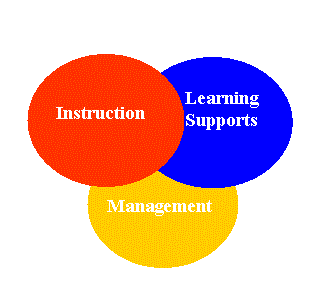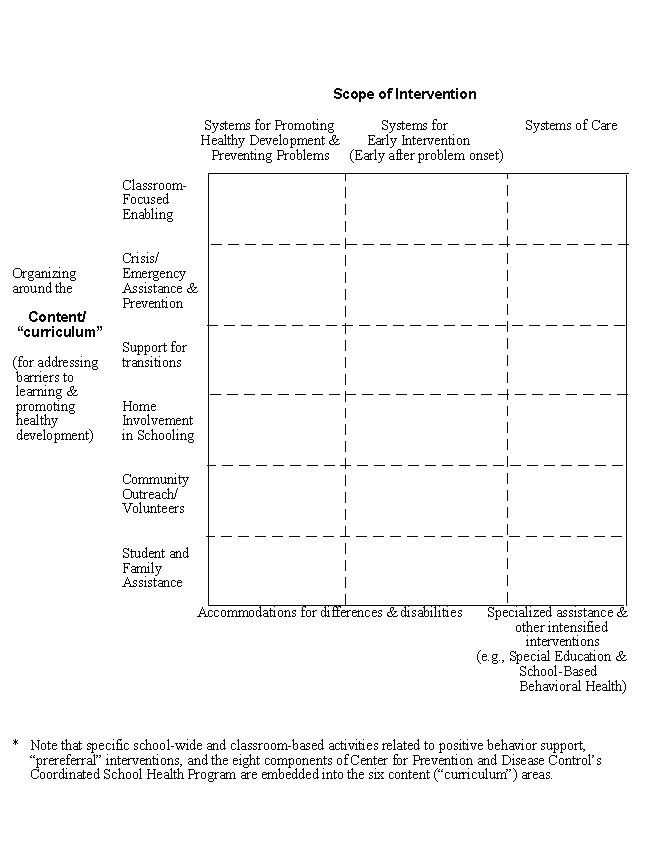
|
About Integrating Student and Learning Supports:
Integrating is Not the Main Point |
As it became clear that the focus on integration was insufficient, our Center has emphasized that, while discussion of integration is useful and seems like a common sense goal, just focusing on integration is a trap. Limiting the focus to integrating student/learning supports has little chance of enhancing equity of opportunity for students across the country. Moreover, as practiced, such a minimal emphasis on systemic change can have serious unintended negative consequences. Our most recent report discussing concerns about all this is: Integrated Student Supports and Equity: What's Not Being Discussed? https://smhp.psych.ucla.edu/pdfdocs/integpolicy.pdf . It highlights the history of reform tinkering guided by integration of services efforts and the failure to produce substantive and sustainable system transformation when the focus has mainly been on such integration.
Of particular concern is that focusing primarily on integration maintains the fragmentation of interventions and does little to reduce the counterproductive competition among those personnel responsible for the various discrete programs and services. And it risks maintaining the marginalization of school/home/community efforts to address learning, behavior, and emotional problems.
So our caution to schools and districts is: Don't make integration seem like the goal and don't let it be the main focus. From our perspective, efforts to better integrate resources should be viewed as just a step in moving toward a fundamental transformation in how schools and communities work together to promote healthy development and address barriers that interfere with development, learning, parenting, and teaching.
The point of moving from a two- to a three-component framework for school improvement is to bring fundamental coherence and end the marginalization of endeavors to address barriers to learning and teaching.

That is, adding a learning supports component to the instructional and management components enables (a) unifying all interventions for addressing barriers to learning and teaching and re-engaging disconnected students and (b) unifying the three components of school improvement. In this context, the first steps are to unify what a school and district currently is doing; this can start with integrating existing resources, but the goal is to transform student and learning supports into a unified system and then develop them into a comprehensive and equitable approach for addressing barriers to learning and teaching and re-engaging disconnected students. As part of the process, the aim is to weave in community and home resources to fill critical gaps, but “integrating” needed community services into school settings, while helpful, is not the main goal.

Because transformation of schools is so difficult, it is easy to get side-tracked and to aim for a few changes and a few immediate outcomes. Indeed, the history of school improvement is strewn with quick fixes and even these usually have not be effectively sustained. Without fundamental and sustainable changes, we continue to see a leveling off after a few years of initial gains in achievement scores and reductions in absences and behavior problems.
The goal of the 2015 National Initiative for Transforming Student and Learning Supports
( https://smhp.psych.ucla.edu/newinitiative.html ) is to guide every school toward unifying and then developing a comprehensive and equitable system for addressing barriers to learning and teaching and re-engaging disconnected students. This requires fully implanting a unified learning supports component into school improvement policy and planning. The point is to enhance equity of opportunity for all students to succeed at school and beyond and foster the type of climate that makes schools the heart of their community.
transforming student and learning supports is fundamental to
enabling equity of opportunity and promoting whole child development.
Let us know what your thoughts are about all this so that we can share them in ways that perhaps can help end the marginalization of efforts to transform student and learning supports.
We look forward to receiving your comments.
Send them to
Ongoing Hot Issue
Back to Hot Topics Home Page
|
Want more information?
Want to connect? Want to be on our mailing list? Click here to sign up. |
|
WebMaster: Perry Nelson (smhp@ucla.edu) |
 |
